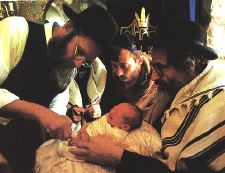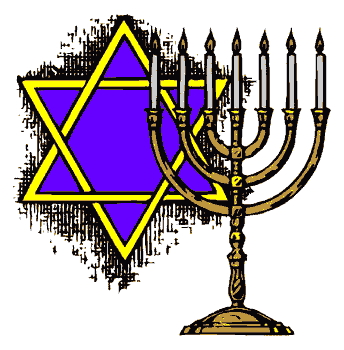Updated May 1st, 2016
The official Jewish view
|
Guest contribution from Rabbi Sholom H. Adler of Toronto
The Origin of Bris Milah Times change. Styles change. But some things never change: Bris Milah is one of them. It is a bond between God and the Jewish nation for all time. It is a bond that can never be broken. |
 MAZEL TOV! IT'S A BOY! |
|
| When our forefather Abraham reached the ripe old age of 99 years (Genesis 17) the Almighty promised him that his descendants would have a special relationship with their Creator. This would forever be symbolized by the Bris Milah (Covenant of Circumcision). “This will be a sign of the covenant between Me and you”. Abraham circumcised himself as well as all the men of his household. When his son Isaac was born, he too, underwent Bris Milah on the eighth day, as divinely specified. |
||
| Heroism Throughout the Ages
Throughout the generations the Jewish people have been unyielding in performing this mitzvah [commandment]. Bris Milah was often performed in secret, defying innumerable despots and hostile régimes. Spain during the Inquisition, Nazi Germany, Communist Russia, ancient Greece and Rome all tried to ban Bris Milah. They understood correctly that this distinctive rite is the cornerstone of the Jewish faith, and that proscribing it would be the first step towards eliminating our nation. The Jewish people, non-observant as well as observant, are uncompromising on this issue. They recognize that in order for their children to survive as Jews, they must induct them into the divine covenant of Bris Milah. Editor's comment - not so, many observant Jews are opposed to circumcision, though many non-observant Jews do follow the covenant. |
||
| The Mohel A Mohel (pronounced Moyel) performs the circumcision with spiritual intent. A Bris by a Mohel is more than a simple medical procedure; it is a connection with the divine. At a Bris Milah blessings are said and prayers are recited as the child takes his place as a member of the Jewish people. Carried out according to Jewish tradition, Bris Milah is a profoundly moving experience for all in attendance. A medical circmcision does not meet all the requirements of Jewish law. |
||
| The Mohel’s Training The Mohel undergoes a prolonged, intensive apprenticeship under the watchful eye of an experienced senior Mohel before being allowed to practise. He must also have broad knowledge of Jewish law, be of good character and committed to observing the Torah commandments. The technique of the contemporary Mohel combines both surgical skill and spirituality. The expert Mohel is a specialist who has advanced the procedure to the highest level. Adherence to rigorous medical standards has always been the rule. In the case of prematurity, low birth weight or illness, the Bris is postponed until the baby is healthy. The Mohel performs the Bris swiftly, with utmost care and minimum discomfort to the infant. Immediately afterwards the baby is returned to his mother to be comforted. | ||
| After the Bris Milah The surgery usually heals uneventfully within a short period of time. The Mohel advises the parents on how to care for and comfort the child during this period and a certificate is issued. |
||
| Highlight of the Jewish Life Cycle
To attend a Bris Milah is to participate in a veritable highlight of the Jewish life cycle. It brings to all present a spiritual feeling that words cannot describe. It’s the Jewish thing to do. The celebration of a new life, a new beginning, is an unparalleled joy - not only for family and friends, but for the entire Jewish nation. At the Bris the baby is given a Hebrew name which further binds him to our glorious tradition. Now he is a full-fledged member of our people. Rabbi Sholom H. Adler, Certified Mohel. Beth Tzedec Congregation of Toronto E-Mail: info@beth-tzedec.org Website: www.beth-tzedec.org |
||
Origins of the three Abrahamic Religions
Three Abrahamic religions. Judaism, Christianity and Islam have a common root; all include stories of the wanderings of the Tribes of Abraham not only in their accounts of early Middle Eastern history but also in many of their religious beliefs deriving from the biblical record.
The biblical record, so far as the Torah (or Pentateuch) is concerned, is a mixture of oral history and pure legend. The account in Genesis of the origin of Jewish circumcision is actually a very convincing story - provided that one throws away the ages of the participants. It actually fits quite well if one halves all the ages mentioned. This is discussed in detail at aboutcirc and please forget ideas about Abraham physically circumcising himself. He had an Egyptian maid, so he was obviously in an area where Egyptians, and therefore circumcisers, lived.
However, many Biblical scholars have discounted the the Genesis account as being a post-facto rationalization, and regard the Exodus story as the real beginning of Jewish circumcision. But Exodus is problematic. For example it is impossible to date the Exodus from Egypt with certainty. From the entire time when the Egyptians kept written records but the Jews did not, nothing survives showing that the Jews ever were in Egypt.
Furthermore, at the time of the exodus, around 3,000BC, there was a strong Egyptian presence in Canaan, as revealed by recent archaelogical excavations. See this site. So it would seen that the Jews were going out of the frying pan into the fire. Anyway, here is the Exodus version. Moses had rescued Zipporah, a Midianite, and her team of shepherdesses from harassment, and in return the Midianite king had given Zipporah to Moses as his wife. We need to remember here that the Midianites already practised circumcision. Not long after, (but cutting a long story short) Moses led the Jews out of Egypt:
At a night encampment on the way, the Lord encountered him and sought to kill him. So Zipporah took a flint and cut off her son’s foreskin, and touched [Moses’] legs with it, saying, ‘You are truly a bridegroom to me!’ And when He let him alone, she added ‘A bridegroom of blood because of the circumcision’ (Exodus 4:24-26, modern translation. Zipporah was the wife of Moses).
The conventional reading is that it is Moses, the father, who is symbolically circumcised. Through the circumcision of his son he is touched in the place where his own fertility comes from. There are two problems here. First, Moses, brought up in an Egyptian noble family, had surely been circumcised before puberty, as was the custom. Secondly, his son should also have been circumcised, but clearly was not. So in fact God was blaming Moses for not circumcising his son, but whether because the boy was Midianite or Jewish is not clear. Fortunately Zipporah, from a circumcising culture, knew what to do.
Circumcision can be seen as a form of ritual bloodletting. A metal knife, called an izmail, is used to perform the circumcision. The traditional izmail is sharp on both sides. This helps to eliminate possibility of harming the child by using a blunt edge. Metzitzah, or drawing, is the act of extracting blood from the wound. The Talmud considers this act to be therapeutic which is reminiscent of other feeling about bloodletting acts such as venesection. There is some controversy over whether this should be done orally or if it can also be done in other ways. The Talmud is strongly opposed to omitting this part of the ceremony and says that any mohel who does not perform it should be removed from office.
[The oral procedure is now forbidden except among the ultra-orthodox on medical grounds, due to the risk of transfer of diseases such as Hepatitis - Ed.] We also need to remember that Talmudic rules do not go back to Biblical times, but date from the first millenium AD.
An act which causes bleeding is a violation of the Sabbath. However, since the Torah specifies exactly when the ceremony is to be performed, eight days after birth, the act of milah wins out over this prohibition. This is a case where an obligatory ceremony cancels out a blood taboo.
Rarely, a boy may be born with a very short foreskin, apparently already circumcised. According to Jewish law, such a boy has to have a drop of blood drawn ritually instead of a circumcision; the same also applies to any converts to Judaism who might already be circumcised. This shows that the blood is as integral a part of the ceremony as the removal of the foreskin. Blood is an integral part of many offerings and sacrifices and the act of circumcision is both an offering and a sacrifice to the covenant with God. The rabbinic notion of salvation is symbolized by the blood of circumcision and the foreskin is the offering with which the people of Israel seal the covenant with Yahweh.

The Duty of Circumcision
It is obligatory for every Jewish father to have his son circumcised. If the father neglects to have his son circumcised, this duty devolves on the Beth-Din (the Ecclesiastical Authorities). Should the child remain uncircumcised, the responsibility falls upon him, on reaching the age of thirteen, to have himself circumcised; and every day he permits to pass without being circumcised, he incurs a penalty.
The Mohel must be an adult circumcised Jew, a believer in and an adherent to the tenets of Judaism and fully acquainted with the method and the laws of circumcision.
[Excerpt from SNOWMAN, Jacob, MD, MRCP, The Surgery of Ritual Circumcision, 3rd edition, London, 1961]

